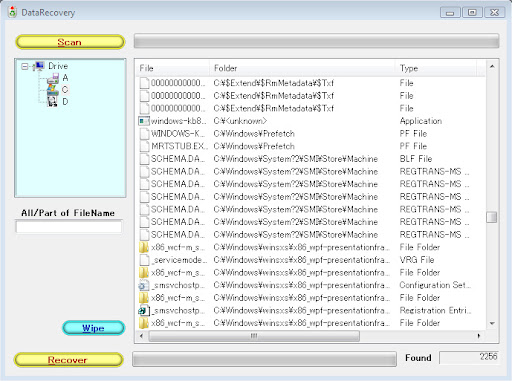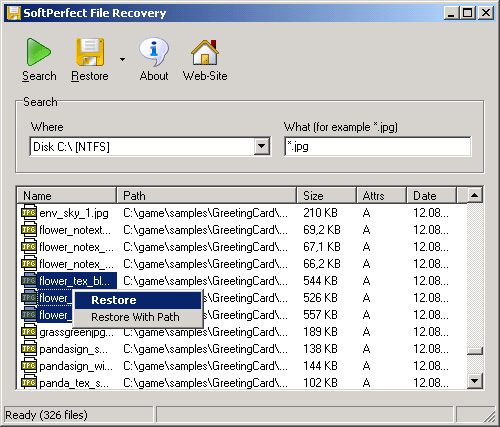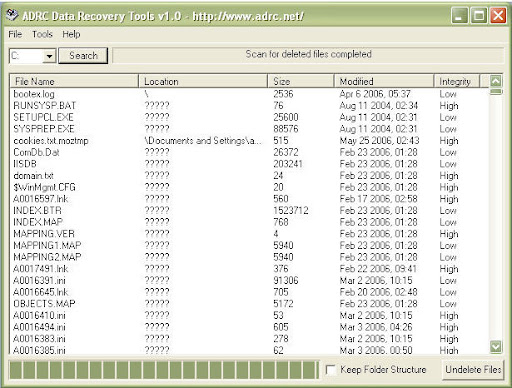Data Recovery Software: What to Look For
When looking for data recovery software, you need to find a solution
that can recover your files from the location where you "lost" them.
Perhaps your PC suffered a virus attack or partitions reformatting.
Maybe you just need to recover a few critical files that were
accidentally deleted. If you lost your files, it is important that you
find software that can attempt to relieve you from your specific
scenario. When we looked for the best data recovery software, we
compared what storage devices they can restore from and their search and
restore filters, basic features and technical support to help you
discover the most suitable product to solve your data-loss problem.
Recoverable Devices
There are many ways to lose a file. Maybe you accidentally deleted a
folder or loaned your USB thumb drive to someone who accidentally lost a
few files for you. Because there are many ways to lose data, we looked
for software that can recover your files from a variety of storage
failures. Most file recovery software can recover deleted files or files
emptied from the recycle bin. However, the best data recovery software
can also find and restore data from altered partitions, damaged sectors
and external drives. Top recovery applications also recover data from a
variety of external disk drives and common items like USB drives and
discs.
Recovery Features
Though most recovery tools have all basic features, we compared them
side-by-side to help you make a better choice about which software
solution will work best to solve your data loss problem. Most software
supports FAT (a variety of types) and NTFS type file systems. However,
some sell FAT or NTFS separately or both types in one product. If you
are unsure, select one that offers both.
Beyond basic recovery features, a few applications provide the ability
to launch the file search regardless of whether you can access Windows.
This is a good option if you want to attempt to recover files without
having to disconnect your suspect disk drive and attach it to a PC that
can run Windows.
Another option that some software includes
is disk imaging. A disk image is an exact image or mirror backup. Disk
imaging is useful for making an image of a damaged disk so that you can
attempt to access "lost" data with less potential for error. Disk
imaging can also create a backup image to prevent loss later.
Search and Recovery Options
Search, filter and sort options are also similar across products. Some
will allow you to search for a specific file type during the initial
search. Others will let you sort the list of discovered files. Most will
let you search by file name, type (or extension), date or file size.
Few recovery tools allow you to search for a specific version of a file,
but most will list the files' creation, last modified and last access
date. Since discovered file lists can be long and often do not contain
the original file name, search tools can be quite useful. File previews
are also helpful. File previews show you an image of the file or the
file code to help you find the file you are hoping to restore.
Help & Support
Recovering lost or deleted files can be complicated. Although the best
file recovery software should be easy to use, there should be help
readily available if you need it. We verified the type of direct support
each company offers, such as telephone, email and instant chat support,
as well as support documentation such as user manuals and product FAQs.
If you need additional assistance, some companies offer professional
data recovery as an additional (but often costly) service.
If you have lost files, there is help. Unless your files have been
written over or are located on a completely demolished disk, there is a
chance you can recover them. With a little patience and the right data
recovery software, you can recoup your losses.
In my experience, accidentally deleting important files or forgetting
to backup important files before formatting are quite often. At first
when i lost my data in a External Hard-drive crash i didn’t know how to
restore my data. But recently i came across these bunch of free
softwares which can restore data from crashed HDD and flash drives.
Before Scan ,Please Read!
When recovering data from accidental deletion, there are some rules to follow.
1. Stop using the hard drive you want to recover as main hard drive
(Windows has disk and registry activity in background. Don’t believe?
Run RegMon, FileMon and DiskMon)
2. Do not install the data recovery software on the hard drive that you want to recover.
3. Do not save the recovered files on the hard drive that you’re recovering.
Do take note that these are my top 10 picks for
FREE data recovery software. Number 1 does not mean it is better than number 5.
1.PC INSPECTOR File Recovery

PC INSPECTOR File Recovery is a data recovery program that supports the
FAT 12/16/32 and NTFS file systems. Finds partitions automatically, even
if the boot sector or FAT has been erased or damaged. Recovers files
with the original time and date stamp. Supports the saving of recovered
files on network drives. Recovers files, even when a header entry is no
longer available. Setup file is 5.83 MB in size.
[
Download PC INSPECTOR File Recovery ]
2.Recuva

From the maker of the popular CCleaner. Recuva (pronounced “recover”) is
a freeware Windows utility to restore files that have been accidentally
deleted from your computer. This includes files emptied from the
Recycle bin as well as images and other files that have been deleted by
user error from digital camera memory cards or MP3 players. It will even
bring back files that have been deleted by bugs, crashes and viruses!
Setup is only 646 KB in size and it’s portable.
[
Download Recuva ]
3.Panda Recovery

Pandora Recovery actually recovers files permanently removed from
Recycle Bin, files originally deleted using Shift + Delete keys
bypassing Recycle Bin and files deleted from DOS prompt. Pandora
Recovery allows you to find and recover recoverable deleted files from
NTFS-formatted volumes, regardless of their type – you can recover
pictures, songs, movies or documents. Setup file is 2.12 MB in size.
[
Download Panda Recovery ]
4.TOKIWA DataRecovery
DataRecovery is freeware and written by TOKIWA to undelete
accidentally deleted files even from recycle bin. It supports FAT12,
FAT16, FAT32 and NTFS undeletion. Even in both NTFS compressed files and
EFS encrypted files. Zip file is only 198 KB in size, no installation
required and it’s portable.

[
Download TOKIWA DataRecovery ]
5.SoftPerfect File Recovery
SoftPerfect File Recovery is a free and useful tool to restore
accidentally deleted files from hard and floppy disks, USB flash drives,
CF and SD cards and other storage media. It supports the popular file
systems such as FAT12, FAT16, FAT32, NTFS and NTFS5 with compression and
encryption. If your important files disappeared and you can’t find
them in the recycle bin, try this software product and get the files
back to life. Easy to use, no installation is required. Program is only
247 KB in size.

[
Download SoftPerfect File Recovery ]
6.Undelete Plus
Undelete Plus is a quick and effective way to restore accidentally
deleted files. It can also recover files that have been emptied from the
Recycle Bin, permanantly deleted files within Windows using the Shift +
Delete, and files that have been deleted from within a Command Prompt.
Undelete Plus works under Win 95/98/Me/NT/2000/XP/2003/Vista operating
systems. The program supports all Windows file systems for hard and
floppy drives including FAT12/16/32,NTFS/NTFS5 and image recovery from
CompactFlash, SmartMedia, MultiMedia and Secure Digital cards. Program
is only 583 KB in size and requires no installation. Portable.

[
Download Undelete Plus ]
7.FreeUndelete
FreeUndelete is data recovery program for deleted files. In case of
accidental deletion of files on a NTFS (used by default in Windows XP,
2000 and NT), FAT32 or FAT16 file systems FreeUndelete is the utility to
help. Setup file is 866 KB in size.

[
Download FreeUndelete ]
8.ADRC Data Recovery Software Tools
ADRC Data Recovery Software Tools contains a collection of DIY data
recovery tools that supports a wide variety of drives and file systems.
The software incorporates extremely simple GUI with novice users in
mind. The software zooms in to do only critical recovery functions with
minimum complexity so one could recover the data easily. It gives you
full control to undelete files, disk image back up, restore a backup
image, copy files from hard disk with bad sectors, disk cloning, backup,
edit and restore your boot parameters. No installation required,
portable and program is only 132 KB in size.

[
Download ADRC Data Recovery Software Tools ]
9.Glary Undelete
Glary Undelete is a free and easy-to-use yet powerful file undelete
solution for FAT and NTFS file systems. It will bring back files emptied
from the Recycle Bin, in a DOS window, from Windows Explorer with the
SHIFT key held down. It will even recover files that have been deleted
by bugs, crashes and viruses! Glary Undelete works under Win
95/98/Me/NT/2000/XP/2003/Vista operating systems. The program supports
all Windows file systems for hard and floppy drives including
FAT12/16/32,NTFS/NTFS5 and image recovery from CompactFlash, SmartMedia,
MultiMedia and Secure Digital cards. Setup is 1.17 MB in size.

[
Download Glary Undelete ]
10.Avira UnErase Personal
Avira UnErase recovers data that have been deleted from the hard
drive either accidentally or as a result of a virus infection, an
uninstaller or defective software. The danger of important data being
lost forever is averted with Avira UnErase. Setup file is 402 KB in
size.

[
Download Avira UnErase Personal ]
There you go, the
top 10 free data recovery software. That should help you get your data back.
and Program for recovery Photo.
PhotoRec
PhotoRec is a program designed to recover erased files, or files that
are not readable due to corrupt partitions etc. Contrary to what its
name implies, Photorec does not only recover photos, but a wide variety
of files as well
[Free, Open Source].
And You can see Paid Data Recovery Program in http://data-recovery-software-review.toptenreviews.com/
















